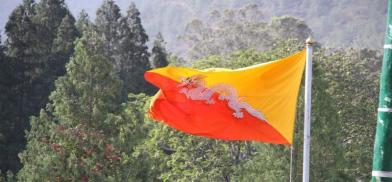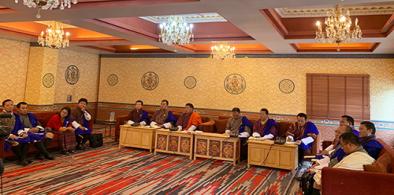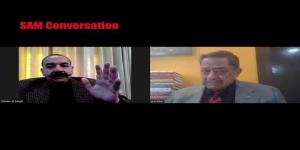Winds of change saves trees in Bhutan
When Ugyen’s father expired in 2018, family members had fallout before hoisting the mani prayers

When Ugyen’s father expired in 2018, family members had fallout before hoisting the mani prayers. The elders wanted to hoist 108 prayer flags while the younger members suggested the conical flag where 108 flags can be strung from a single tree.
Ugyen and his siblings convinced the elders. He recalls getting accused by his elders of looking for an easy way to wash their hands off the ritual but he reasoned that cutting 108 fresh trees for the dead might rather hinder his liberation. “Buddhist believe that all living things have a life. It is the same as killing,” he said.
In the face of a shortage of new wooden flagpoles and rising environmental concerns from deforestation, Bhutan's younger generations in urban areas have resorted to conical, steel and bamboo flagpoles. The conventional style, for many who understands the impact on the environment, could be a welcome change.
A naturalist, Tshultrim, said that the pressure on the forest resource from cutting trees is visible on the mountains. “Each time a person dies, young trees are cut and younger ones are prone to a forest fire.”
Tshering Penjor said that trees cut down for flagpoles are environmentally harmful and the future consequences might be dire. When the tree is cut, the whole ecosystem niche is disturbed, he said. He said that other alternatives such as hoisting prayer flags on bamboo and steel is logical as long as the mantras on the flags are visible and hoisted.
“The purpose is served and the culture has to evolve with time too.”
Rinzin, 68, from Wangduephodrang said that the new way of hoisting prayer flags in urban areas was in line with the Tibetan bon tradition. In Tibet, it was difficult to find trees, therefore, they had to look for other alternatives. “The new method is easier, but I have only hoisted using the wooden poles.”
The bark has to be removed to reduce fungal infection, which also helps flags flutter properly. The tree has to be new, he added.
The pressure on the forest is in the records of the forestry department.
Last year alone, Thimphu forest division issued 6,912 trees to be used as flagpoles within the Chang, Dagala, Mewang and Kawang gewogs. On average, it amounts to 18 trees a day.
The record with the forest department showed an increasing trend of trees issued as flagpoles over the years. From 2012 to 2017, 189,105 flagpoles were issued across different parts of the country. Since 2012 until last year, it is 26,499.35 m3 of trees. A normal truck can carry between eight and 16 m3 of wood.
Species such as blue pine, hemlock, chirpine, symplocus, sliver fir, spruce, larix, juniper, bamboo, eucalyptus and cryptomeria are used as flagpoles.
While the department maintains that people chose fresh trees over old ones for prayer flags to help the dead find the right path in the next life, the chief forestry officer of Thimphu, Gyeltshen Drukpa, said that except for 29 fresh trees, many people were reusing old poles.
He said that increasing demand for wooden flagpoles had rather helped in forest management through thinning and removal of the old and the infected trees. The department issues woods from fire-prone areas that are bound to die and vulnerable to infection from bark beetle.
Gyeltshen Drukpa said that the department had asked the Natural Resource Development Corporation limited to take ownership of allocating the flagpoles. “It would be commercially viable and would also help in providing better service for people.”
The royalty is Nu 2 per pole in rural areas and Nu 4 in urban areas.
Buddhist believe in hoisting 108 fresh prayer flags for the deceased. But in recent years, in the town areas like Thimphu, the tradition has observed a drastic change.
The new method, however, might have a negative impact on horned wildlife, said some conservationists. It would be an introduction of new elements in their habitat which would take time for them to adapt. Negative impact would be inevitable.
Although culture dictates 108 prayer flags for a death ritual, a former lam Neten with the central monastic body, said that it was not necessary and none of the Buddhist scriptures make it mandatory. “It doesn’t matter what the prayer flag is attached to as long as the mantras on the flags are lucid.”
Buddhism values live and believe that the trees also have a life force, which if cut would result in accumulating negative karma. Bhutanese connect hoisting prayer flags to the trinity Buddha—Avalokiteshvara, Manjushri and Vajrapani—but there are no written rules.
“People hoist 108 flags to fulfill cultural beliefs,” the former Lam Neten said.
It is believed that the more flags you hoist, the better is the benefit for the deceased. “This adds pressure on the people and the forest,” said Ugyen. When his uncle died last year, he failed to convince his cousin. They hoisted 500 prayers in Thimphu and Paro mostly reusing old flagpoles.
https://kuenselonline.com/189105-trees-lost-to-flagpoles-in-six-years/
















Post a Comment